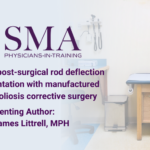Abstract | May 5, 2021
Investigation of post-surgical rod deflection using instrumentation with manufactured curvature in scoliosis corrective surgery
Learning Objectives
- Evaluate the differences in post-operative stability and rod deflection among patients treated for scoliosis using straight rods versus curved rods;
- Expand awareness of patient-specific, pre-manufactured rods used for scoliosis correction surgery;
- Expand awareness of various characteristics that affect implant stability in othropaedic surgery.
Introduction
Adolescent idiopathic scoliosis (AIS) is a three-dimensional spinal deformity without a known cause1. Ideally, most scoliosis can be managed nonoperatively2. Yet with spinal curvatures beyond 45-50°, surgical treatment is considered. In order to surgically correct spinal deformities a multi-level spinal fusion, stabilized with rod implants, is the standard approach3. During surgery, the rods are bent in the stagittal plane to achieve a natural lordosis/kyphosis profile, which introduces imperfections within the implant and can decrease stiffness4,5. When the rods are loaded as part of the correction maneuver, they tend to lose their stagittal curvature resulting in a reduction of the deformity correction. This process is known as post-surgical rod deflection6. Traditionally, the implants are manufactured as straight rods and post-surgical rod deflection can be controlled by changing other aspects about the implant, such as the stiffness or rod diameter. However increasing implant stiffness or rod diameter can lead adverse consequences, such as osteonecrosis. A newer alternative is a rod with a patient-specific, pre-manufactured stagittal curvature. While there are various structural characteristics that influence rod stability, a pre-manufactured stagittal curvature is hypothesized to provide additional stability to the implant and help prevent post-surgical rod deflection7.
Goals
Using a retrospective chart review, the authors will measure the implant curvature from pre-surgical imaging with intra-operative and post-operative imaging. Using a case-control study, our ultimate goal is to track deflection in three dimensions by using tangent lines. The authors will match subjects and controls on various factors, such as age and sex.
Through this project we aim to compare the amount of rod deflection between the newer, alternative to the traditional, straight rod implant. Although most research that explores rod stability focuses on rod diameter and composition, the authors see this as an opportunity to increase awareness of patient-specific implants and hope that the results of this study can help highlight novel characteristics that can provide additional stability to orthopaedic implants.
References and Resources
- Edgar M: The natural history of unfused scoliosis. Orthopedics 1987, 10(6):931-939.
- Weinstein SL, Dolan LA, Spratt KF, Peterson KK, Spoonamore MJ, Ponseti IV: Health and function of patients with untreated idiopathic scoliosis. JAMA 2003, 289:559-567.
- Harington PR: Treatment of scoliosis. Correction and internal fixation by spine instrumentation. J Bone Joint Surg Am 1962, 44:591-610.
- Picetti GD III, Pang D, Bueff HU: Thoracoscopic techniques for the treatment of scoliosis: early results in procedure development. Neurosurgery 2002, 51:978-984.
- Winter RB, Lonstein JE, Denis F: How much correction is enough? Spine 2007, 32:2641-2643.
- Sia U, Tan BB, Teo YY, Wong CC. Post-implantation Deformation of Titanium Rod and Cobalt Chrome Rod in Adolescent Idiopathic Scoliosis. Malays Orthop J. 2019;13(1):14-19. doi:10.5704/MOJ.1903.002
- Ohrt-Nissen S, Dahl B, Gehrchen M (2018) Choice of rods in surgical treatment of adolescent idiopathic scoliosis: what are the clinical implications of biomechanical properties?—a review of the literature. Neurospine 15(2):123–130.

